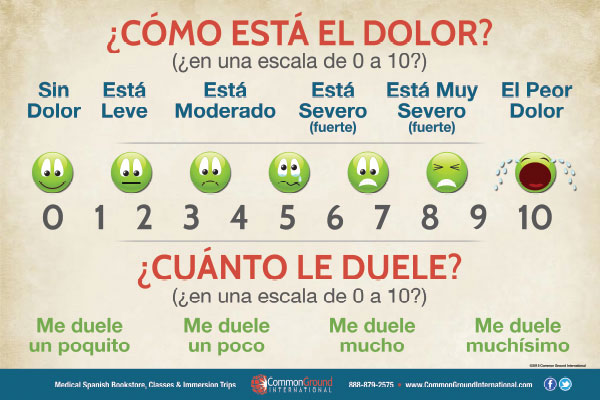This Medical Spanish lesson focuses on how to talk about pain in Spanish and understanding the different words to describe it when talking with your Spanish speaking patients.
Here is the Pain in Spanish lesson I taught to the Facebook group:
Subscribe to our YouTube Channel to see all of our lessons and get the latest videos right away!
Basic Keywords
- Dolor: The noun “pain”. Example: Tiene dolor de cabeza
- Duele (doler): The verb “to hurt”. Example: Me duele el pecho.
- Adolorido: Adjective, hurt, sore or aching Example: Tengo las rodillas adoloridas
- Doloroso: Adjective painful. Example: Una fractura es dolorosa.
Where? – ¿Dónde?
¿Qué le duele? / ¿Dónde le duele?
Remember: “le” is referring to usted / él / ella (something hurts you / him / her). When talking to kids you can use “te” instead of “le”.
| When talking to adults | When talking to kids |
| ¿Qué le duele? (what hurts?) | ¿Qué te duele? |
| ¿Dónde le duele? Where does it hurt? | ¿Dónde te duele? |
| ¿Le duele el / la…? Does your ____ hurt? (singular) | ¿Te duele el / la…? |
| ¿Le duelen los / las…? Does your ____ hurt? (plural) | ¿Te duelen los / las…? |
Indíqueme dónde le duele:
- Aquí / acá (here)
- Arriba / abajo (Up / Down or Above / Below)
- Delante de / detrás de (In front of / Behind)
- Adentro / Afuera (Inside / Outside)
- Encima de (On top of)
[grid]
[row]
[column eight wide]
When? – ¿Cuándo?
¿Cuándo le duele? – When does it hurt?
- Por la… mañana / tarde / noche (During the / in the morning / afternoon / evening)
- Antes de… / después de… (Before… / After…)
- Mientras…. (While… / During…)
- De repente… (Suddenly…)
¿Le duele cuando….? – Does it hurt when….?
- Le duele cuando orina / respira profundo
- Le duele cuando mueve el / la / los____
How Often? – ¿Con qué frecuencia?
¿Con qué frecuencia / cada cuánto le duele?
- De vez en cuando
- A menudo
- Con frecuencia
- Casi nunca
- Siempre / es constante
[/column][column eight wide]
How Long? – Por cuánto tiempo
- ¿Por cuánto tiempo ha tenido este dolor?
- ¿Desde cuándo le duele?
- ¿Hace cuánto que tiene este dolor?
How Much? – ¿Cuánto?
¿Cuánto le duele en una escala de 0 a 10?
- 0 = sin dolor
- 1 – 3 = está leve
- 3 – 5 = está moderado
- 6 – 7 = está severo
- 8 – 9 = está muy severo
- 10 = el peor dolor
¿Cuánto le duele?
- No me duele
- Me duele un poquito
- Me duele mucho
- Me duele muchísimo
[/column]
[/row]
[/grid]
 What Kind? – ¿Qué tipo (Qué clase)?
What Kind? – ¿Qué tipo (Qué clase)?
¿Qué tipo / qué clase de dolor es?
- El dolor va y viene / es intermitente
- Es constante
- Es ardiente / es quemante
- Es con presión / es pesado
- Es punzante
- Es irradiado / corre por (x)
- Es agudo
- Es sordo
What Were You Doing? – ¿Qué estaba haciendo?
- ¿Qué hacía cuándo el dolor empezó?
- ¿Qué pasaba cuándo el dolor empezó?
- ¿Dónde estaba cuándo el dolor empezó?
What Makes You Feel Better / Worse? – ¿Qué le hace sentir mejor / peor?
- ¿Qué lo hace mejor / peor?
- ¿Toma medicina para el dolor?
- ¿Qué toma?
- ¿La medicina ayuda?
Study pain assessment vocabulary in Spanish with these flashcards
I packaged all of this into easily downloadable .pdf notes– Get your copy for free today!
Keep up the good work speaking responsible Spanish to your patients! Check out our other books, classes & products to help you !
*If the link isn’t working for you, you may need to unblock pop-ups in your browser settings.
[button link=”https://commongroundinternational.com/medical-spanish/verbs-nouns-adjectives-that-describe-injuries-in-spanish/” size=”medium” style=”download” bg_color=”74aa50″ border=”74aa50″]Related Lesson: Verbs, Nouns & Adjectives that Describe Injuries in Spanish[/button]


 What Kind? – ¿Qué tipo (Qué clase)?
What Kind? – ¿Qué tipo (Qué clase)?


Pingback: How To Talk About Abdominal Pain in Spanish | Common Ground International Language Services
Pingback: Video Viernes - How To Talk About Abdominal Pain in Spanish | Common Ground International Language Services